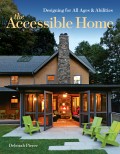 Deborah Pierce, AIA, CAPS, is an author, architect, and supporter of PYD. Her latest book, The Accessible Home: Designing for All Ages and Abilities, “goes beyond ramps and grab-bars to help aging boomers, or those faced with disabilities, accomplish home accessibility on a deeper level.”
Deborah Pierce, AIA, CAPS, is an author, architect, and supporter of PYD. Her latest book, The Accessible Home: Designing for All Ages and Abilities, “goes beyond ramps and grab-bars to help aging boomers, or those faced with disabilities, accomplish home accessibility on a deeper level.”
For each of us, there comes a moment when the Nature of Reality is revealed. It can be an accident or illness, for ourselves or for those we love, that leaves us forever changed. Things that seemed under our control turn out to be an illusion. We watch others going about their daily activities – perhaps rushed or mindless – thinking they have all the time in the world, when we know in our bones that this is not so.
I’ve had several such brushes with Fate – the death of my baby daughter, born prematurely, and of my brother, hit by a drunk driver, and a cancer diagnosis were three big awakenings. Facing each one of these was an exercise in adjusting to a “new normal.” In talking with friends who have survived catastrophic injuries or who live with degenerative illness, I hear similar wisdom. Out of the fear comes a kind of fearlessness, knowing one has faced the unthinkable and survived. We have a second chance to live with the knowledge that life is precious, and also that we can achieve the impossible.
The Accessible Home: Designing for All Ages and Abilities is an introduction to 25 remarkable people who have made this journey. It is also an ideas-book that shows how thoughtful design makes it possible to live well despite having disabilities. The homes featured in this book are unique because they do not present the usual “barriers” to mobility. For example, when sinks have space for wheelchairs below, and faucets that do not require a gripping or twisting motion, the simple act of washing-up is transformed from a dis-ability to an ability.
These and other modifications can be easily made to an older building, and make new buildings more appealing to a wider range of users and visitors. Accessible design is neither institutional nor medicinal. It’s what is possible when people with disabilities communicate how they need to do things, and when thoughtful designers listen.
“The world is not what is handed to you, but rather, what you make of it.” – Brian McMillan
“So many of our dreams at first seem impossible, then they seem improbable, and then, when we summon the will, they soon become inevitable.” – Christopher Reeve

